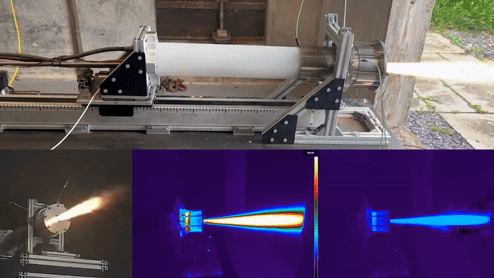

As satellite constellations and space junk continue crowding orbital zones above Earth, researchers are searching for ways to prevent adding to the growing problem. According to one team of researchers, one solution may involve using the physical rocket to fuel its own launch.
Collaborators from the University of Glasgow say they have debuted the first successful, unsupported autophage (Latin for “self-eating”) rocket engine prototype. Revealed earlier this week during the American Institute of Aeronautics and Astronautics SciTech Forum, the Ouroboros-3—named after the ancient Egyptian symbol of a snake eating its own tail—utilizes its own body as an additional fuel source. In a video of the tests, the Ouroboros-3 can be seen shrinking in length as its body is burned away during a simulated launch.

Today’s conventional rocketry stores its fuel in separate stages that are ejected once depleted, either to burn up during atmospheric re-entry or to become yet another piece of orbital space junk. Ouroboros-3 leaves very little trace once it completes its duties, given that it would only be tasked with launching and delivering a small, unpiloted payload into orbit.
After a first ignition using a main propellant composed of gaseous oxygen and liquid propane, Ouroboros-3’s high-density polyethylene plastic tubing encasement subsequently adds to the propulsion as the rocket continues its burn. Much like a candlestick flame consuming its wax, the case provided as much as one-fifth the total necessary propellant. In test-firings, Ouroboros-3 generated as much as 100 newtons of thrust.
“A conventional rocket’s structure makes up between five and 12 percent of its total mass. Our tests show that the Ouroboros-3 can burn a very similar amount of its own structural mass as propellant,” University of Glasgow engineering professor and project lead Patrick Harkness said in a statement earlier this week. “If we could make at least some of that mass available for payload instead, it would be a compelling prospect for future rocket designs.”
Subsequent tests also demonstrated how the team can control their autophage rocket’s burn, allowing it to restart, pulse in an on/off pattern, or be throttled.
“These results are a foundational step on the way to developing a fully-functional autophage rocket engine,” Harkness continued.
[Related: The FCC just dished out their first space junk fine.]
Although still an early prototype, the team hopes to scale future iterations of Ouroboros-3 enough to support the delivery of payloads, such as nanosatellites, into orbit without further cluttering the atmosphere. Speaking with Gizmodo on Thursday, Harkness intends to strengthen their autophage rocket by around two orders of magnitude—any more than that is probably unnecessary, since deliveries will likely be restricted to comparatively small payloads.
Still, autophage rockets could one day provide the space industry with an alternative to existing designs’ costly, cluttering problems. And besides, anything that helps avoid instigating a Kessler cascade is certainly good news.
